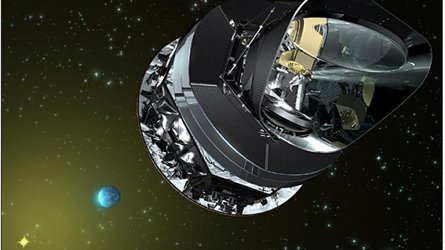Notes for Editors
Back to news story: Planck reveals an almost perfect Universe
A series of scientific papers describing the new results will be published on 22 March.
Background information on the topics discussed in this release is available by following the links on the right-hand side of this page.
The new data from Planck are based on the first 15.5 months of its all-sky surveys. Launched in 2009, Planck was designed to map the sky in nine frequencies using two state-of-the-art instruments: the Low Frequency Instrument (LFI), which includes the frequency bands 30–70 GHz, and the High Frequency Instrument (HFI), which includes the frequency bands 100–857 GHz. HFI completed its survey in January 2012, while LFI continues to operate.
Planck’s first all-sky image was released in 2010 and the first scientific data were released in 2011. Since then, scientists have been extracting the foreground emissions that lie between us and the Universe’s first light to reveal the CMB presented in this release. The next set of cosmology data will be released in early 2014.
The Planck Scientific Collaboration consists of all the scientists who have contributed to the development of the Planck mission, and who participate in the scientific exploitation of the Planck data during the proprietary period. These scientists are members of one or more of four consortia: the LFI Consortium, the HFI Consortium, the DK-Planck Consortium, and ESA's Planck Science Office. The two European-led Planck Data Processing Centres are located in Paris, France and Trieste, Italy.
The LFI consortium is led by N. Mandolesi, Agenzia Spaziale Italiana ASI, Italy (deputy PI: M. Bersanelli, Universita' degli Studi di Milano, Italy), and was responsible for the development and operation of the LFI instrument. The HFI consortium is led by J.L. Puget, Institut d’Astrophysique Spatiale in Orsay, France (deputy PI: F. Bouchet, Institut d'Astrophysique de Paris, France), and was responsible for the development and operation of the HFI instrument.
The Institut d’Astrophysique Spatiale in Orsay is a Unité Mixte de Recherche (UMR8617) of the CNRS (Centre National de la Recherche Scientifique) and the Université Paris-Sud 11. The Institut d’Astrophysique de Paris is a Unité Mixte de Recherche (UMR 7095) of the CNRS and the Université Pierre et Marie Curie of Paris.
The development of the Planck mission was supported by substantial financial and technological contributions of ESA member states. More than 40% of the mission’s development cost was provided by the agencies supplying HFI and LFI. France and Italy, through the two leading funding agencies CNES and ASI, and the national research bodies, provided more than half of the national funding.
The contribution of ESA member states is even more significant for the scientific operation of the mission and the processing of its data.
ESA member states also provided key technologies such as the innovative cooler that enabled the mission’s instrumentation to be maintained atjust one-tenth of a degree above absolute zero (–273.15°C). Important technologies and payload elements were also contributed by NASA.
For further information, please contact:
Markus Bauer
ESA Science and Robotic Exploration Communication Officer
Tel: +31 71 565 6799
Mob: +31 61 594 3 954
Email: markus.bauer@esa.int
George Efstathiou
University of Cambridge, UK
Tel: +44 1223 337530
Email: gpe@ast.cam.ac.uk
François Bouchet
Institut d’Astrophysique de Paris, France
Tel: +33 1 44 32 80 95
Email: bouchet@iap.fr
Paolo Natoli
University of Ferrara, Italy
Tel: +39 0532 97 42 44
Email: Paolo.Natoli@unife.it
Jan Tauber
ESA Planck Project Scientist
Tel: +31 71 565 5342
Email: Jan.Tauber@esa.int




